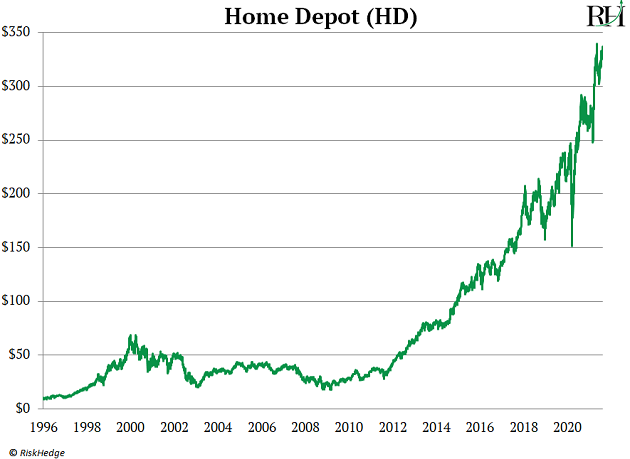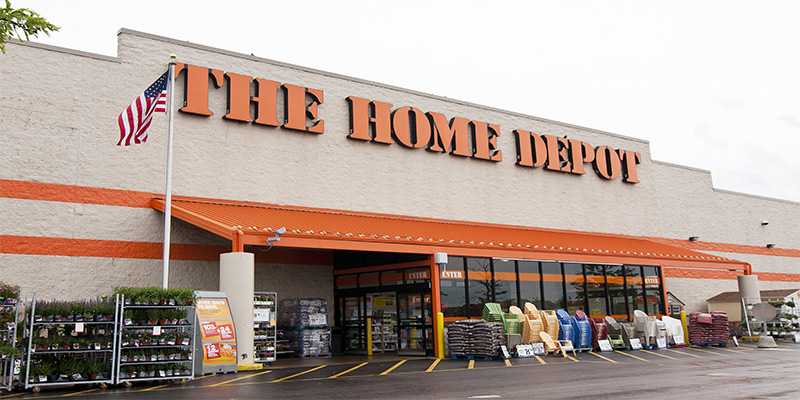** How to "forget" about $128K
** You'll laugh at this study...
** Stephen's top "undisruptible" stocks
Chris… If it weren’t for my wife, I still wouldn’t know about that pile of money.
My friend John told me a crazy story over coffee…
One that’s 100X more powerful than any “hot stock tip.”
“It was 1996,” he said. “I was managing apartment buildings and shopping at Home Depot 2–3 days a week.
Every time I walked in there, the place was PACKED. I was just getting started investing… but I knew I needed a piece of this business.”
John enrolled in their direct stock purchase plan (DSPP), which automatically buys a fixed dollar amount of shares on a regular basis.
“I put an initial $2,500 in, and set it up to buy $75 more every month.”
For the first couple months, John carefully watched his account grow.
Then the newness wore off... and he forgot about it.
John moved to Costa Rica and turned his attention to real estate. After a successful career there, he and his family moved to Delray Beach, Florida, in 2015.
“Here we were 20 years later, going over our finances. That’s when my wife looked up and asked: Honey, what ever happened to those Home Depot shares?”
John didn’t even know his password to log into his account.
But when he finally figured it out, he was stunned at the number…
“It was $128,000, Chris…”
This is the #1 trait of successful investors...
A few years ago, brokerage firm Fidelity conducted a study. The results were hilarious...
They found that investors who performed the best had one thing in common:
They forgot they had an account!
These investors weren’t trading in and out of positions... they weren’t trying to catch the next “high-flying” stock… they weren’t trying to “time” the market.
They weren’t doing anything!
Yet their portfolios were blowing everyone else’s out of the water.
This, and John’s story, reveals a very important investing truth.
Owning world-class businesses—and holding them for the long haul—is one of the most reliable ways to build lasting wealth.
Now, John’s $128,000 nest egg didn’t appear overnight. In fact, it took 20 years. But it was the least stressful $100K he ever made. And the stock’s still booming today…

The thing with world-class businesses is you don’t need to log into your account every day and monitor them. They’re simple. They solve problems. And you never have to worry about them “going out of style.”
As Chief Analyst Stephen McBride recently showed us, people are buying and renovating homes in droves now. And people will continue to buy homes—and renovate them—for the next hundred years.
Remember, John didn’t overthink his decision to jump on Home Depot. He saw everything he needed the minute he set foot in that store 20 years ago…
Stephen says when it comes to these types of businesses, the best time to sell is “never”…
He told me the #1 mistake investors make when trying to invest this way is dumping world-class businesses the minute they sell off.
We’re not talking about penny stocks here. We’re talking about owning the most dominant businesses on the planet. You’re not going to get wealthy trying to “time” your entry and exit points perfectly.
Of course, the challenge is figuring out which dominators will remain dominant, and which ones are sitting ducks to be disrupted. For every Home Depot there’s an ExxonMobil (XOM)...
Exxon reigned as one of the world’s most dominant companies for 40 years. From 1974 to 2014, anyone who invested a big part of their life savings in Exxon stock looked like a genius.
But then everything changed. Oil as our primary source of fuel is on its way out. Over the past seven years, Exxon stock has been a total disaster... torching investors’ money to the tune of
-44%.
Like Stephen said... disruption comes at you fast. So how do you tell the difference between a true dominator and a sitting duck?
In his Disruption Investor advisory, Stephen focuses on the world dominators doing the disrupting… NOT the ones getting disrupted.
Two of his favorites right now are at the heart of one of the most unstoppable trends on earth…
The end of the traditional banks. And the rise of “new money” disruptors.
Specifically, he’s betting on Mastercard (MA) and Visa (V).
These guys don’t get nearly as much attention as hot stocks like Tesla or Netflix. But Visa and Mastercard have handed investors big gains over the past decade. I expect that to continue for the next decade… and beyond.
If you’re like the average American, you carry four credit cards in your wallet. While all the cards are from different banks—and they all have their own special privileges, prestigious names, and color schemes—most have one thing in common: “Visa” or “Mastercard” stamped on the bottom right.
It hardly matters what bank you use. Your card likely uses one of these payment networks to function. In fact, there are 3.4 billion Visa and 2.6 billion Mastercard cards in circulation!
These are two of the most consistently impressive businesses I’ve ever analyzed. They absolutely dominate the market for moving money around, and will continue to for a long time.
Stephen says Visa and Mastercard’s position at the core of the global payments system makes them one of the safest bets for the long haul. Unlike Exxon, they’re what he calls “undisruptible.”
And the best part? You can buy them, forget about them, and get on with your life…
(And if your spouse asks about them years from now, you may be surprised at the number in your account, too…)
Chris Reilly
Executive Editor, RiskHedge
P.S. If you’re looking for another great stock doing the disrupting, Stephen discovered a lesser-known name that’s set up to collect a cut of potentially every online transaction in America.
That means every time a guy pays his monthly Netflix bill... or books a vacation on Expedia... or buys clothes, diapers, or dog food online...
This one small company gets paid. As a stockholder, you get paid. He calls it the “Amazon Killer.” It’s the only stock he owns in his daughter’s college fund. And you can get all the details right here.




